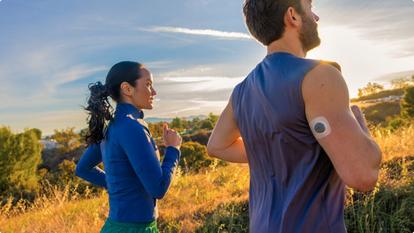Fitness
Spring into fitness: Healthy tips and exercises to stay active
Published: Mar. 18, 2025
4 min read

The content in this article should not be taken as medical advice. Please consult with your healthcare provider regarding your individual health needs.
Exercise isn’t just great for your heart and muscles—it’s also a powerful way to maintain healthy glucose levels. Whether you’re living with diabetes or simply want to optimize your glucose health, regular physical activity is key.
Here are six tips to get you moving this spring in ways that are the most beneficial to your glucose health.
1. Understand why physical activity matters
When you move, your muscles use glucose as fuel. This helps lower glucose levels and improves insulin sensitivity (meaning your body needs less insulin to manage glucose levels). The American Diabetes Association highlights some benefits that exercise can provide, including:
- Lowering glucose during and after activity
- Enhancing insulin sensitivity so your body needs less insulin
- Reducing the risk of long-term diabetes complications

2. Choose activities that work for you (and your glucose)
Here are three types of activities to focus on for more effective glucose management:
Aerobic activities
Think walking, jogging, swimming, or dancing—anything that gets your heart pumping helps you use glucose more efficiently. A great goal is to aim for at least 150 minutes per week of moderate aerobic activity (e.g., 30 minutes per day for 5 days), but don’t let that number put you off. Any amount of aerobic exercise is beneficial, and 150 minutes can be something to work up to.
Strength training
Build muscle with resistance exercises like weightlifting or bodyweight workouts. Doing these 2-3 times a week can improve insulin sensitivity and promote glucose uptake, helping to lower overall glucose levels.
More movement throughout the day
Break up long periods of sitting with short activity bursts. Studies show that even a few minutes of standing or walking every 30 minutes can improve glycemic health.
3. Time your workouts strategically
When’s the best time to exercise? According to Harvard Medical School, post-meal movement is especially effective. A walk or light activity after your largest meal of the day can help prevent glucose spikes and support digestion.
4. Stay safe
Exercise is incredibly beneficial, but staying safe is important. Here’s how:
Track your glucose levels
Different types of activity can have different impact on glucose levels. This is why it's a great idea to use a glucose biosensor like Stelo to check your levels before, during, and after exercise to learn which kinds of activity, at which times, make the biggest impact.
Start slow
If you’re new to exercise, take it easy. Start with light activities like walking and gradually build up intensity over time.
Stay consistent
Moderate, regular exercise is better than sporadic intense sessions. Finding something you enjoy will help you stick with it.
Hydrate and prepare
Keep water on hand to stay hydrated. With increased energy output from activity, it’s also a great idea to have snacks available to keep energy levels up, especially for longer workouts.
Consult your healthcare provider
If you’re living with diabetes, it’s always a good idea to work with your healthcare provider, physical therapist, or trainer to create a tailored plan.
5. Incorporate simple, everyday habits
Remember: don’t underestimate the power of small changes. Try these quick and easy ideas:
- Try parking further away than necessary so you can get some extra steps
- Choose the stairs over the elevator for a quick cardio boost
- Practice yoga to reduce stress and stabilize blood sugar
- If balance or mobility is a challenge, try chair stretches or seated resistance exercises to support strength and flexibility

6. Celebrate every step
Physical activity is one of the best tools for optimal glucose health and overall wellness — it’s all about finding what works for you. Start small, have fun, and celebrate your progress. Every bit of movement adds up.
Ready to take the first step? Let’s do this.

Reviewed by: Kayce Sol
MA, RN, BSN, CDCES
MA, RN, BSN, CDCES
Kayce Sol is a registered nurse and certified diabetes care and education specialist.

Written by: Stelo Team
References: